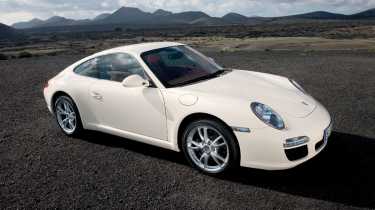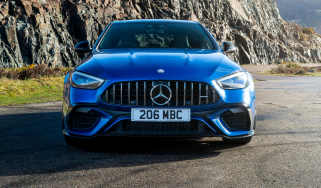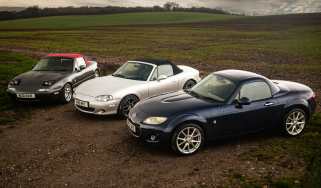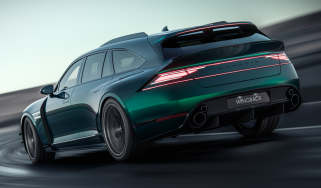Porsche 997 Mk2
Updated 911 gets new engines and double-clutch gearbox option
The Porsche Doppelkupplungsgetriebe makes driving a very emotional experience. That’s what Gerd Bofinger, Porsche’s expert in all things double-clutch, will tell you. But then the now-obsolete Tiptronic gearbox, a torque-converter automatic with a fancy manualisation mode and a sluggish shifting habit, could make driving an emotional experience too. It could almost bring me to tears at its ruination of a perfectly good 911.
This PDK, as you’ll be pleased to hear it can be called for short, has to be a massive improvement. Porsche invented the idea 25 years ago, using it first in the 956 racing car, so it’s surprising that it has taken so long to appear in a roadgoing Porsche given that Audi, for example, has had its DSG for five years now. Anyway, it’s here, and its sophistication makes up for lost time. It has wet clutches, seven gears and three shift regimes, the hardest-core one demonstrating shades of the instant abruptness found in the Ferrari F1-SuperFast system’s Race mode and previously alien to the double-clutch world. It even has a launch control.
Should you have one? We’ll come to that in a minute. Whatever new 911 Carrera 2 or 2S you might buy, though, you will have the other great new 997 novelty. The engine has gone direct injection, which has meant not just new cylinder heads but a complete engine redesign with every significant component changed. The 3.6-litre gains 18cc in cylinder capacity with fractional increases in bore and stroke, while the 3.8-litre S unit loses 24cc despite a bigger bore. It’s now very oversquare at 102mm/77.5mm, which suits its new 7600rpm rev limit.
More reviews
Group tests
- Lotus Emira Turbo SE v Alpine A110 GTS – two of the last surviving mid-engined sports cars
- Alpine A290 v Alpine A110 – how much DNA do they really share?
- Ariel Atom 4R v Caterham Seven ‘evo25’: power-to-weight heroes go head-to-head
- Ariel Atom 4 v Caterham Seven 310R v Lotus Elise Cup 250
- £200,000 supercar shoot-out: AMG v Aston Martin v Maserati v McLaren
- Audi Quattro, RS2 and RS3: five-cylinder icons head-to-head
- Who makes the best GT car? Aston Martin v Bentley v Maserati
- Caterham Super Seven 600 v Super Seven 2000
- Corvette Stingray v Porsche Cayman GTS v Audi R8 RWD
- Great Ferrari hypercars driven: 288 GTO, F40, F50 and Enzo head-to-head
In-depth reviews
- Abarth 600e 2025 review – Italy gives the Alpine A290 something to worry about
- Alpine A110 review – the sports car Lotus should be building
- Aston Martin Vantage 2025 review – a thrilling Mercedes-AMG GT and 911 Turbo S alternative
- Used Audi RS2 (1994) review – an unsung '90s hero you can own for £40k
- Audi R8 (2015 - 2024) review – the ultimate soft-focus supercar
Long term tests
- Abarth 695C Turismo Fast Fleet test – living with the charming Italian hatch
- Alfa Romeo Giulia Veloce long term test – can Italy beat Germany?
- Alpina B10: Alpina B10: end of term report
- Aston Martin Vantage (2006) Fast Fleet test – living with a £30k V8 Aston
- Caterham Seven evo25 Fast Fleet test – living with a track car for the road
- Caterham Seven evo Edition revealed – bespoke 420R joins the Fast Fleet
- Cupra Leon 300 Fast Fleet test – living with Spain's 300bhp hot hatch
- Cupra Ateca VZN Fast Fleet test – four months with Cupra's hot crossover
- Cupra Leon Estate 310 4Drive Fast Fleet test – living with the 306bhp hot estate
- Ford Mustang GT
Review
- New Bentley Batur 2023 review – can it possibly be worth £1.65m?
- 2023 Chevrolet Corvette C8 Z06 review – the American 911 GT3?
- BBR Supercharged Mazda MX-5 (ND) 2023 review – tuned 250bhp roadster driven
- MG4 Trophy 2023 review
Reviews
- Abarth 695 75 Anniversario edition 2024 review – a fitting send-off for Abarth’s hot supermini?
- Abarth 500e 2023 review
- AC Cobra 378 Superblower MkIV 2021 review – another V8 Cobra, but with a GM heart this time
- Acura Integra Type S 2024 review – a Honda Civic Type R with added restraint
- Alfa Romeo Giulia review – get one while you still can
- Alfa Romeo 33 Stradale 2025 review – a rare Italian jewel beyond compare
- Alfa Romeo SZ: history, review and specs of an icon
The new engines are more powerful, cleaner, lighter and have fewer parts. Their direct injection has no lean-burn phase but does alter the timing and number of its injection pulses according to speed and load. One DI benefit is the cooling effect of injecting fuel into the hot, compressed cylinder air at the top of the compression stroke, which allows a higher compression ratio (now 12.5:1), but there’s also a squirt during the intake stroke when needed for extra power.
Injection pressure, incidentally, is less than a tenth of a typical modern DI diesel’s, even though the compression ratio is three-quarters as high. That’s because petrol is more ‘liquid’ and combustion timing is (obviously) by a spark. A diesel’s self-ignition involves a much shorter, more accurate squirt that calls for much higher pressure levels.
Another innovation is an electronically controlled oil pump, still crankshaft-driven but with output now dependent on need rather than speed. It’s designed to give proper lubrication even during maximum-g cornering manoeuvres that might see the oil doing its best to stay stranded in one of the flat-six’s cam covers.
All of the above helps the new 911s (recognise them by the LED running lights in the nose) travel around 15 per cent further on the same amount of fuel, with the basic Carrera 3.6 now rated at 225g/km CO2 and snicking into tax band F. Yet that car now has 341bhp against 321 before, while the S rises by 30bhp to 380. This relatively mainstream 911 can now touch 188mph…
As for acceleration, the PDK (co-created with ZF) changes the rules and out-sprints the manual: 0-62mph takes 4.9sec in the manual Carrera, 4.7sec with PDK. For the S the figures read 4.7 and 4.5. Faster shift-times and closer gear ratios are why, and there’s another 0.2sec to be shaved off if you use the PDK’s Sport Plus mode and its driveshaft-torturing launch control (6500rpm then auto-dump the clutch). Sport Plus is part of a Sport Chrono Package, which includes, as before, adaptive dampers and a built-in stopwatch.
It all works with predictable efficiency. And maybe that’s the subtle snag. The new engine is extremely smooth, and on a light throttle makes very little noise. Open its throat and rev it hard, and you’ll get a crisp, clean howl with a hard edge but few of the ingredients that have long exercised motoring writers’ minds for new ways of describing a 911’s aural output. It sounds like the free-breathing flat-six it is, but the colour has faded.
It’s very keen to hurl you down the road, though, especially when helped by the full Sport Chrono PDK as fitted to our Carrera S test car. Seventh is a cruising gear (35.4mph per 1000rpm) and is locked out in Sport Plus mode. The six ratios below it arrive at the prod of a thumb (up) or the pull of a finger (down), provided you remember which plasticky steering-wheel button to press, which takes practice. The Sport button speeds the shifts without adding the snatches felt in Sport Plus, and firms-up the dampers too. If you think the ride too choppy, as it will be on a bumpy road, you can separately switch the dampers back to suppleness, just as Porsche’s own test drivers do when tackling the Nürburgring.
The PDK works as you would expect. It’s quicker-shifting than a Tiptronic, ultimately slower-shifting than a Ferrari F1-SuperFast in maximum-attack mode, but much smoother and better in every way than Aston Martin’s Sportshift. And in automatic it’s excellent: smooth and civilised in normal mode, good at keeping the engine between max torque and max power in Sport Plus.
Does all this make an optimum 911? Technically yes, but some of the emotion is missing compared with a proper DIY manual. Whatever Herr Bofinger might say.
Specifications
| Engine | Flat-six, 3800cc |
| Max power | 380bhp @ 6500rpm |
| Max torque | 310lb ft @ 4400rpm |
| 0-60 | 4.3sec (claimed, with PDK) |
| Top speed | 188mph (claimed) |
| On sale | July |



